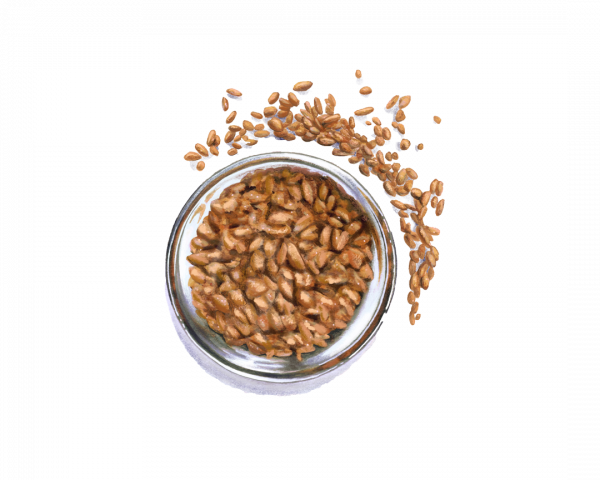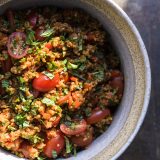
Because different varieties of bulgur absorb liquid differently, choosing the right one can make or break a recipe. While coarse bulgur softens in about 15 minutes, fine bulgur becomes mushy in that time.
Bulgur comes in four grinds: fine (#1), medium (#2), coarse (#3) and extra-coarse (#4). Fine bulgur is a perfect binder when kneaded into meatballs. Medium bulgur is good for porridge and, once hydrated, for mixing into muffin batter and bread dough to add crunch.
More substantial coarse and extra-coarse bulgurs require longer cooking and are the best choices for pilafs, salads and soups. ◆
Our search for a robust rethinking of tabbouleh, the light and lemony grain salad of the Levant, required a trip down the Silk Road, the ancient trade lane linking China and the ports of the Mediterranean.It was along that route that bulgur—parboiled, dried cracked wheat, a key ingredient in tabbouleh—was transformed by traders.
Tabbouleh, a bulgur- and tomato-laced salad, is mostly made of finely chopped parsley and mint. We wanted a heartier salad dominated by the nutty flavor and chewy texture of bulgur. To find our recipe, we had to understand a bit of history.
Bulgur is nearly as old as civilization itself, with a history stretching back 4,000 years. It proved particularly valuable to Silk Road merchants who prized its nutritional value and resistance to spoilage. Thus it became embedded in the flavorful cuisines along the road. Today, variations on a salad of bulgur, onion and herbs stretch from Turkey (kisir) to the Levant (tabbouleh), Syria (bazergan) and the former Soviet republics of central Asia (plov).
At Milk Street, we were most intrigued by Armenia’s version, eetch, built on a hearty bulgur base and sautéed onion, garlic, bell pepper and tomatoes. The tomatoes cook down into a sauce, flavoring the wheat.
For our version, we wanted to combine the freshness of tabbouleh with the robust flavors of eetch. We sautéed red bell pepper and scallions, spicing the mix with Aleppo pepper, cumin and garlic. To that we added tomato paste and the bulgur, which absorbed those deep flavors. After a brief boil, it took just minutes off the heat for the bulgur to finish cooking.
Once the bulgur cooled slightly, we folded in some sweet-tart pomegranate molasses—another common ingredient in the Middle East—for a bright, tangy note. Mixing in raw grape tomatoes balanced the tomato paste’s deep flavor, and chopped mint and more scallions provided a fresh contrast that reminded us of our starting point: tabbouleh.
Related Recipes
July-August 2018

Sign up to receive texts
Successfully signed up to receive texts!
We'll only send our very best offers - Like a $15 store credit to start.
By entering your phone number and submitting this form, you consent to receive marketing text messages (such as promotion codes and cart reminders) from Christopher Kimball's Milk Street at the number provided, including messages sent by autodialer. Consent is not a condition of any purchase. Message and data rates may apply. Message frequency varies. You can unsubscribe at any time by replying STOP or clicking the unsubscribe link (where available) in one of our messages. View our Privacy Policy and Terms of Service.



